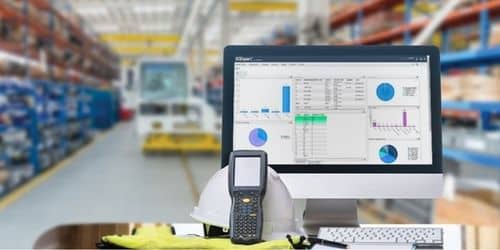Warehouse management is an essential component of supply chain management if your small business stores the commodities it sells in a warehouse. Warehouse management is critical for tracking the products your business keeps on hand and maintaining ideal levels so you can promptly fulfill customer orders. Understanding how to create a warehouse management system – and the inventory management software your small business requires to support it – is critical to keeping track of your inventory, reducing loss and theft, and keeping customers happy by rapidly filling orders. Here we’ll go through what inventory warehouse management is all about and we’ll have a review of the 10 best inventory warehouse management software in 2023.
What is Warehouse Inventory Management?
Warehouse inventory management is the process of receiving, tracking, auditing, and managing merchandise stored in a warehouse or other storage facility for order fulfillment. It also involves stock replenishment when specified minimum amounts are met, bringing your inventory back up to appropriate levels based on past sales data. Warehouse management, like other inventory management systems, is concerned with controlling incoming and outgoing products while also knowing where specific components are placed.
Warehouse management is a subset of inventory management, which oversees all products held by a corporation from the creation of purchase orders for suppliers to the safe delivery of products to clients. It is concerned with the arrangement and tracking of merchandise while it is in storage, as well as the speed with which certain items are sold.
What is the Distinction Between Warehouse Management and Inventory Management?
Warehouse management is concerned with items maintained in warehouses and storage facilities, as opposed to those kept in storefronts or used in the manufacturing process. It is part of the larger inventory management process, which tracks merchandise from the time of acquisition through the point of sale. However, while that merchandise is in storage at your warehouse, you must have a mechanism in place to ensure it does not go missing and is ready to sell when the time comes.
Warehouse management system is part of a larger inventory management procedure that ensures things are transported out to shops or customers on schedule. When a sale is made or a transfer order arrives, the warehouse should be set up so that employees can rapidly pick, pack, and send things. This entails keeping products in predictable areas and then following them from the time they leave the warehouse door until they arrive at their destination.
What is the Operation of Warehouse Inventory Management Systems?
Warehouse inventory management software has several vital elements that will assist you in monitoring the products in your storage facilities and managing inventory control. In some circumstances, warehouse management system software is integrated into larger enterprise resource planning (ERP) software packages; in others, warehouse management software is used as a stand-alone system. If you want to manage your inventory across your company’s whole environment, it is best to purchase a seamlessly integrated procedure.
Inventory management software handles product procurement, tracking, and shipping, ensuring you know where your products are at all times. They can also be used as forecasting tools, allowing you to order things based on predicted client demand based on previous sales data. Some additionally provide warnings and notifications to optimize your warehouse’s operational process, such as alerting when it is time to complete cycle counts.
The Best Warehouse Inventory Management System Software
- NetSuite – the best option for inventory management and eCommerce applications together.
- Mobe3 WMS – The best software for optimizing routes and warehouse layouts.
- Sphere WMS – The best alternative for tracking warehouse inventory levels.
- Infoplus – the best software for creating personalized report dashboards.
- Odoo – the best all-in-one solution for sales and warehouse applications.
- SkuVault – the best software for integrating third-party systems.
- IRMS360 – The best system for tracking supply chains and inventory control.
- HighJump – the best solution for automating warehouses and increasing production.
- Blue Link ERP – the best alternative for small and medium-sized businesses.
- Manhattan – The best solution for advanced supply management with AI and machine intelligence.
Read The Reviews To Find Your Ideal Warehouse Inventory Management System
#1. NetSuite
NetSuite, a cloud-based warehouse management system, combines a variety of features into a single, simple-to-use solution. Its revolutionary tool suite combines cash flow, financial, inventory, payroll, and other functions into a single platform, allowing users complete control over their business.
SuiteCommerce is a component of this toolkit, representing a unified solution that supports both B2B and B2C eCommerce for maximum convenience. NetSuite provides a comprehensive approach to eCommerce management, including features such as multiple channel order management and real-time inventory visibility.
NetSuite customers can even construct their own landing pages, publish new material, and run promotions, while user-friendly drag-and-drop tools make it easy to manage content and change sites.
As an extra plus, NetSuite is highly scalable, allowing for an extension as well as easy upgrades and implementation. Your site will always be up to date with the most cutting-edge technology thanks to automated upgrades and new features that arrive with each release.
Pros:
- Inventory management, order management, and online marketing all in one.
- Order management and processing via several channels.
- A single platform supports both B2C and B2B eCommerce.
- Excellent scalability to meet your business’s needs.
- Easy-to-use drag-and-drop tools for maximum ease.
Cons:
- There are no out-of-the-box third-party integrations.
#2. WMS Mobe3
With Mobe3 WMS, you can easily structure your warehouse layout and increase direct picking paths. Manual errors are removed, and the efficiency and productivity of your warehouse personnel are increased, thanks to SmartBarcode scanning.
Mobe3 WMS software is simple to implement and quick to learn. It’s a highly usable solution thanks to its user-friendly, readily navigable interface.
This tool is easily configurable and versatile, and it connects with ERPs and other systems such as MES, TMS, and weight scales. This makes it an ideal choice for usage in any distribution hub.
Mobe3 WMS is a cost-effective logistics system that assists you in maintaining inventory correctness at all times.
Pros:
- Integration with systems such as MES, TMS, and weight scales, as well as ERPs, is simple.
- Configurable and adaptable.
- A user-friendly, simple-to-navigate interface.
- Because it can read barcodes, it eliminates the risk of human error.
Cons:
- It is possible that older devices or previous iOS mobile device versions will not always be compatible.
#3. WMS Sphere
If you want a simple solution to improve visibility, efficiency, and control over your warehouse floor operations, Sphere WMS is an excellent option. It has every feature you might want to increase your company’s efficiency, including real-time reports and web visibility, wireless barcode scanning, an iOS app, and customizable customization.
Sphere WMS also performs admirably in terms of integrations. There are numerous third-party connector choices available, including online shopping carts and popular eCommerce sites such as Amazon, Etsy, PayPal, and WooCommerce.
Sphere WMS pricing is customizable, so you may select alternatives that best match your needs. There is also a free demo available so you can see if it’s the correct software for you before you buy.
Sphere WMS is a difficult warehouse management solution, but its comprehensive capabilities make it a very detailed system for in-depth real-time inventory control.
Pros
- There are numerous third-party integration possibilities available, including popular eCommerce sites.
- Wireless barcode scanning, real-time reports, and an iOS app are among the advanced capabilities.
- There is a free demo version available.
- The pricing for this software is adaptable to your company’s specific requirements.
Cons
- Some users may find some of the features to be difficult to utilize.
#4. Infoplus
Infoplus is the right choice when you require a full WMS with the purchase and inbound, shipping management and outbound, building blocks, inventory control, configurable reports, dashboards, stock control, customer portals, and real-time shipment tracking.
It is a powerful and adaptable software solution that integrates with over 120 carriers, carts, and other platforms, including household names like Walmart Marketplace, Etsy, and Amazon Seller Central. It provides good value for money because of its remarkable array of features.
One of Infoplus’s best benefits is its variable pricing. It provides low-cost solutions that are incredibly affordable if you are running a small business or a fresh start-up.
The pricing plan at Infoplus is likewise highly transparent, allowing you to make an informed purchasing decision.
Pros:
- Excellent report dashboard customization.
- Over 120 integration possibilities with common carts and carriers.
- There is a free demo version available.
- For SMEs, transparent pricing plans with flexible alternatives are available.
Cons:
- Inadequate statistics and reporting tools.
#5. Odoo
If you’re running a small business on a tight budget, you won’t find a more economical and cost-effective warehouse inventory management solution than Odoo.
This software allows you to use one app absolutely free of charge while installing a second app only costs a small fee. As a result, this system provides excellent value for money.
From productivity tools and operations to sales and websites, this range of sales and warehouse solutions covers it all. The software employs automated RFQs and order points, allowing the supply chain to be effortlessly refreshed.
Odoo provides its own entire array of first-party apps and software to make users’ lives easier and more pleasant. Third-party integrations can, however, be connected using Zapier if desired.
Pros
- Users can access a comprehensive range of first-party apps and software.
- Zapier allows for third-party integrations.
- For one app, a free basic package is provided.
- Odoo’s entry-level pricing is incredibly reasonable.
Cons
- Customizing this software can be difficult at times.
#6. SkuVault
This cloud-based inventory management software is created primarily for multi-channel and eCommerce merchants. SkuVault employs real-time data to sync with online marketplaces like as eBay, Amazon, Shopify, and Magento when dealing with physical and actual inventory as it is scanned in and out of the store or warehouse.
SkuVault syncs with quantities in real-time, preventing out-of-stocks and reducing shipping, picking, and packing errors. Meanwhile, smart reordering reports ensure that purchasing decisions are supported by actual data.
SkuVault can boost efficiency while also enhancing your company’s bottom line. Evidence suggests that users can reduce out-of-stocks by up to 10 times, labor expenses can be lowered by up to 30%, and fulfillment times can be cut by up to 87%.
Even more, SkuVault shines in the area of integrations. Integration options include well-known eCommerce platforms such as eBay, Amazon, Etsy, Magento, and Shopify, among others.
Pros
- There is a diverse set of connectors accessible, including huge names like eBay, Amazon, and Shopify.
- The setup is simple and straightforward.
- There is a free demo available.
- It has been shown to cut fulfillment time and labor expenses.
Cons
- Some functions are difficult to use and navigate.
#7. IRMS360
Whether you run a large organization or a small-scale distribution center, IRMS360 is the best cloud-based warehouse management system for you.
IRMS360 enables you to maximize your available space and resources, assisting with fulfillment, by providing outstanding control and visibility over all your processes. This software provides a complete 360-degree perspective of the supply chain, with performance dashboards that provide real-time visibility of products, processes, and people as they move across your warehouse floor.
IRMS360 is available on all mobile systems, including Windows, Android, and iOS, and interfaces effortlessly with a variety of MRP, CRM, ERP, and accounting systems. Meanwhile, third-party billing, yard, and transportation management, demand planning, and labor management are all available through its expanded capability.
Whether you are in healthcare, food, and beverage, wholesale distribution, automotive, metals, publishing, or 3PL warehouses, IRMS360 will streamline your procedures and improve your warehouse service.
Pros
- Oracle, SAGE X3, QuickBooks, Amazon RDS, and other popular connections are provided.
- Suitable for all sizes and types of operations.
- There is a free demo available.
- Available for all mobile systems, including Android, iOS, and Windows.
Cons
- The search tool is not particularly user-friendly.
Read Also: Top 25 Warehouse Management Systems Software In 2023
#8. HighJump
HighJump may be the best warehouse inventory management software for you if you require an agile WMS solution to make your supply chain more dynamic.
It was created to increase productivity while decreasing operating costs. It employs cutting-edge technologies to minimize order turnaround windows while maximizing capacity and throughput. This sophisticated program has several capabilities that allow advanced users to fully use the system’s potential.
HighJump, with its simple, modern user interface, is an excellent solution for automating warehouses and increasing production tremendously.
HighJump has exceptional flexibility and versatility due to its ability to effectively interact with major ERP providers. For added ease and compatibility, HighJump can also provide customized integration for custom-built and legacy ERP systems.
Pros
- Full integration with major ERP vendors, as well as bespoke integration for custom-built and older ERP systems.
- Robust software with outstanding features for advanced users.
- A user interface that is both intuitive and modern.
- A tried-and-true method for increasing productivity by maximizing capacity and output.
Cons
- With this software, there is a significant learning curve to overcome.
#9. Blue Link ERP (Enterprise Resource Planning)
Blue Link ERP is the best all-in-one solution whether you manage a small or medium-sized distribution or wholesale business.
Its completely integrated system provides complete user-friendly features that allow you to manage accounting, inventory, order processing and entry, and warehouse management with ease. Blue Link ERP provides easy access and outstanding readability because of its user-friendly interface.
Blue Link ERP’s ability to interact with barcode scanners, tablets, and common carriers is a good feature. This software also comes with a free demonstration so you can see if it’s the correct fit for you before purchasing.
Finally, Blue Link ERP succeeds in its onboarding process since it delivers in-house expert training, support, implementation, and in-person advising.
Pros
- Smaller-scale consumers searching for a functional warehouse management system will find this product ideal.
- User-friendly UI that is sensible and well-organized.
- A free demo is available.
- It integrates effortlessly with barcode scanners, tablets, and common carriers.
Cons
- Not suitable for large-scale businesses.
#10. Manhattan
Manhattan may be the correct choice for you if you’re seeking for one of the most advanced supply management solutions on the market today.
It is an effective warehouse inventory management system that leverages the power of machine learning and the most recent AI technologies. Manhattan is a streamlined and efficient piece of software that is designed to optimize throughput and fulfillment for both WAVELESS and WAVE orders in a single platform.
Manhattan can provide you with all the functionality you need to streamline shipping and receiving in order to expedite back-ordered products and facilitate cross-docking. In the meanwhile, its user interface is straightforward.
Another advantage is Manhattan’s specialized WMS team, which writes SQL server programming.
Pros
- A single platform solution for WAVELESS and WAVE order fulfillment at the same time.
- Scripting can be written by a dedicated WMS team.
- An easy-to-use user interface.
- Allows for cross-docking while also expediting back-ordered products.
Cons
- There are no mentions of third-party integrations.
Conclusion
As you can see, if you want your distribution or warehousing business to be profitable and competitive, you must adopt high-quality warehouse inventory management software. However, it is critical to select the best software solution for your company’s requirements.
We investigated all possibilities and concluded that NetSuite is the best WMS option for your organization at this moment. This software is efficient, effective, and convenient as a single solution that fulfills all of your demands, making it the ideal choice for any business.
Warehouse Inventory Management Software FAQs
How do warehouses track their inventory?
Scanning things when they are first received, scanning them throughout the warehouse process, and then scanning them again when they are dispatched to customers enables convenient material tracking.
What is a WMS in a warehouse?
A warehouse management system (WMS) is a software solution that provides visibility into a company’s full inventory and oversees supply chain fulfillment activities from the distribution center to the store shelf.
How do you set up a warehouse inventory?
Begin by purchasing count tags, count sheets, and any other items required. Assign personnel to go through each section of the warehouse prior to the inventory date. They should mark and store damaged and old inventory. Count and affix count tags to all products that will not be used before the inventory.
- LIST OF MOST PROFITABLE SMALL BUSINESSES: Top 35 (+ Detailed Guide)
- Things You Need To Know Before Installing Warehouse Fans
- ERP SYSTEMS: Top Best Options in 2023 (Updated!!)
- ERP SYSTEM: Meaning, Examples, and Top 5 Picks
- 5 Reasons Why ERP Software Is Important for Growth






